Chuanrui Zhang
DAGait: Generalized Skeleton-Guided Data Alignment for Gait Recognition
Mar 24, 2025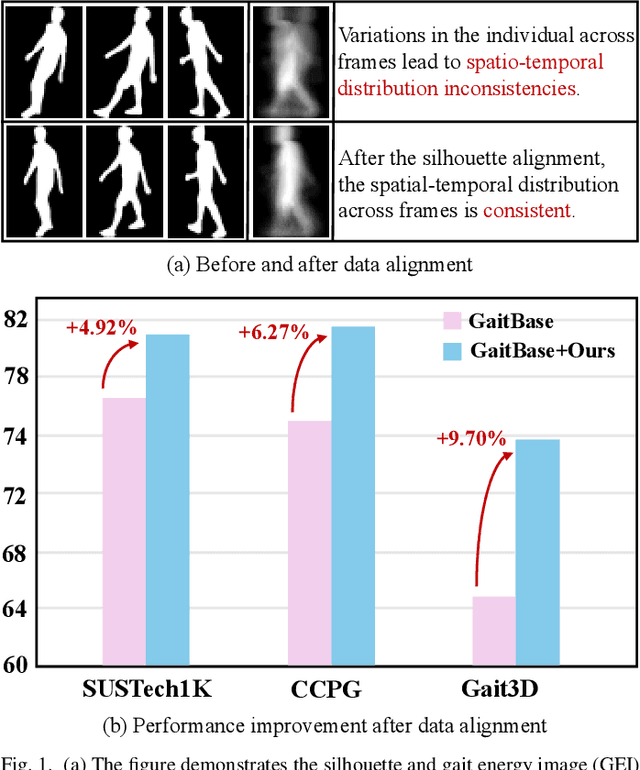
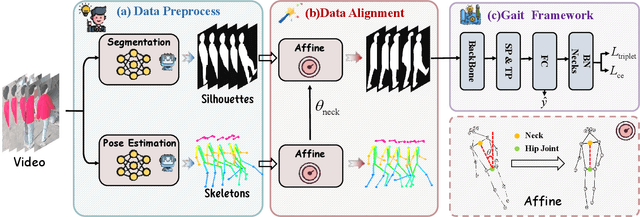
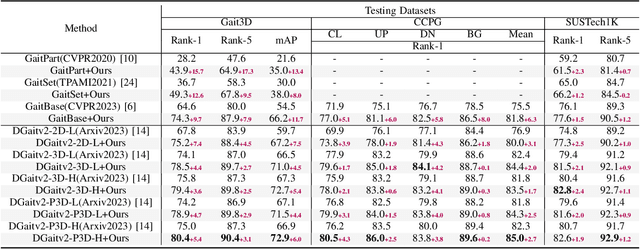

Abstract:Gait recognition is emerging as a promising and innovative area within the field of computer vision, widely applied to remote person identification. Although existing gait recognition methods have achieved substantial success in controlled laboratory datasets, their performance often declines significantly when transitioning to wild datasets.We argue that the performance gap can be primarily attributed to the spatio-temporal distribution inconsistencies present in wild datasets, where subjects appear at varying angles, positions, and distances across the frames. To achieve accurate gait recognition in the wild, we propose a skeleton-guided silhouette alignment strategy, which uses prior knowledge of the skeletons to perform affine transformations on the corresponding silhouettes.To the best of our knowledge, this is the first study to explore the impact of data alignment on gait recognition. We conducted extensive experiments across multiple datasets and network architectures, and the results demonstrate the significant advantages of our proposed alignment strategy.Specifically, on the challenging Gait3D dataset, our method achieved an average performance improvement of 7.9% across all evaluated networks. Furthermore, our method achieves substantial improvements on cross-domain datasets, with accuracy improvements of up to 24.0%.
PSGait: Multimodal Gait Recognition using Parsing Skeleton
Mar 15, 2025Abstract:Gait recognition has emerged as a robust biometric modality due to its non-intrusive nature and resilience to occlusion. Conventional gait recognition methods typically rely on silhouettes or skeletons. Despite their success in gait recognition for controlled laboratory environments, they usually fail in real-world scenarios due to their limited information entropy for gait representations. To achieve accurate gait recognition in the wild, we propose a novel gait representation, named Parsing Skeleton. This representation innovatively introduces the skeleton-guided human parsing method to capture fine-grained body dynamics, so they have much higher information entropy to encode the shapes and dynamics of fine-grained human parts during walking. Moreover, to effectively explore the capability of the parsing skeleton representation, we propose a novel parsing skeleton-based gait recognition framework, named PSGait, which takes parsing skeletons and silhouettes as input. By fusing these two modalities, the resulting image sequences are fed into gait recognition models for enhanced individual differentiation. We conduct comprehensive benchmarks on various datasets to evaluate our model. PSGait outperforms existing state-of-the-art multimodal methods. Furthermore, as a plug-and-play method, PSGait leads to a maximum improvement of 10.9% in Rank-1 accuracy across various gait recognition models. These results demonstrate the effectiveness and versatility of parsing skeletons for gait recognition in the wild, establishing PSGait as a new state-of-the-art approach for multimodal gait recognition.
MuDG: Taming Multi-modal Diffusion with Gaussian Splatting for Urban Scene Reconstruction
Mar 13, 2025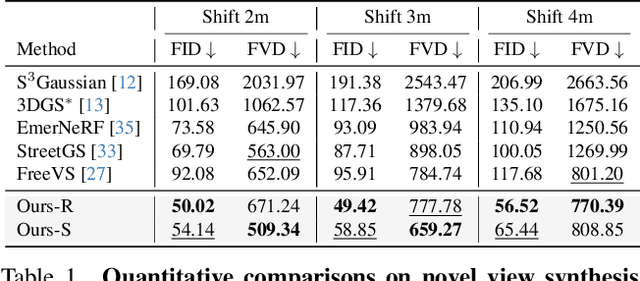
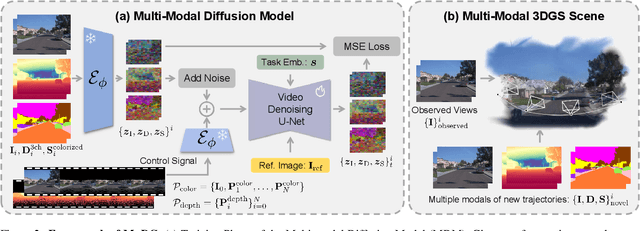

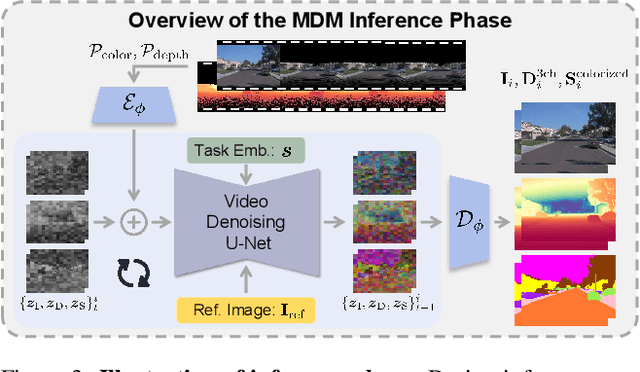
Abstract:Recent breakthroughs in radiance fields have significantly advanced 3D scene reconstruction and novel view synthesis (NVS) in autonomous driving. Nevertheless, critical limitations persist: reconstruction-based methods exhibit substantial performance deterioration under significant viewpoint deviations from training trajectories, while generation-based techniques struggle with temporal coherence and precise scene controllability. To overcome these challenges, we present MuDG, an innovative framework that integrates Multi-modal Diffusion model with Gaussian Splatting (GS) for Urban Scene Reconstruction. MuDG leverages aggregated LiDAR point clouds with RGB and geometric priors to condition a multi-modal video diffusion model, synthesizing photorealistic RGB, depth, and semantic outputs for novel viewpoints. This synthesis pipeline enables feed-forward NVS without computationally intensive per-scene optimization, providing comprehensive supervision signals to refine 3DGS representations for rendering robustness enhancement under extreme viewpoint changes. Experiments on the Open Waymo Dataset demonstrate that MuDG outperforms existing methods in both reconstruction and synthesis quality.
TranSplat: Generalizable 3D Gaussian Splatting from Sparse Multi-View Images with Transformers
Aug 25, 2024



Abstract:Compared with previous 3D reconstruction methods like Nerf, recent Generalizable 3D Gaussian Splatting (G-3DGS) methods demonstrate impressive efficiency even in the sparse-view setting. However, the promising reconstruction performance of existing G-3DGS methods relies heavily on accurate multi-view feature matching, which is quite challenging. Especially for the scenes that have many non-overlapping areas between various views and contain numerous similar regions, the matching performance of existing methods is poor and the reconstruction precision is limited. To address this problem, we develop a strategy that utilizes a predicted depth confidence map to guide accurate local feature matching. In addition, we propose to utilize the knowledge of existing monocular depth estimation models as prior to boost the depth estimation precision in non-overlapping areas between views. Combining the proposed strategies, we present a novel G-3DGS method named TranSplat, which obtains the best performance on both the RealEstate10K and ACID benchmarks while maintaining competitive speed and presenting strong cross-dataset generalization ability. Our code, and demos will be available at: https://xingyoujun.github.io/transplat.
Category-level Object Detection, Pose Estimation and Reconstruction from Stereo Images
Jul 09, 2024Abstract:We study the 3D object understanding task for manipulating everyday objects with different material properties (diffuse, specular, transparent and mixed). Existing monocular and RGB-D methods suffer from scale ambiguity due to missing or imprecise depth measurements. We present CODERS, a one-stage approach for Category-level Object Detection, pose Estimation and Reconstruction from Stereo images. The base of our pipeline is an implicit stereo matching module that combines stereo image features with 3D position information. Concatenating this presented module and the following transform-decoder architecture leads to end-to-end learning of multiple tasks required by robot manipulation. Our approach significantly outperforms all competing methods in the public TOD dataset. Furthermore, trained on simulated data, CODERS generalize well to unseen category-level object instances in real-world robot manipulation experiments. Our dataset, code, and demos will be available on our project page.
VoxelFormer: Bird's-Eye-View Feature Generation based on Dual-view Attention for Multi-view 3D Object Detection
Apr 03, 2023Abstract:In recent years, transformer-based detectors have demonstrated remarkable performance in 2D visual perception tasks. However, their performance in multi-view 3D object detection remains inferior to the state-of-the-art (SOTA) of convolutional neural network based detectors. In this work, we investigate this issue from the perspective of bird's-eye-view (BEV) feature generation. Specifically, we examine the BEV feature generation method employed by the transformer-based SOTA, BEVFormer, and identify its two limitations: (i) it only generates attention weights from BEV, which precludes the use of lidar points for supervision, and (ii) it aggregates camera view features to the BEV through deformable sampling, which only selects a small subset of features and fails to exploit all information. To overcome these limitations, we propose a novel BEV feature generation method, dual-view attention, which generates attention weights from both the BEV and camera view. This method encodes all camera features into the BEV feature. By combining dual-view attention with the BEVFormer architecture, we build a new detector named VoxelFormer. Extensive experiments are conducted on the nuScenes benchmark to verify the superiority of dual-view attention and VoxelForer. We observe that even only adopting 3 encoders and 1 historical frame during training, VoxelFormer still outperforms BEVFormer significantly. When trained in the same setting, VoxelFormer can surpass BEVFormer by 4.9% NDS point. Code is available at: https://github.com/Lizhuoling/VoxelFormer-public.git.
Delving into the Pre-training Paradigm of Monocular 3D Object Detection
Jun 15, 2022



Abstract:The labels of monocular 3D object detection (M3OD) are expensive to obtain. Meanwhile, there usually exists numerous unlabeled data in practical applications, and pre-training is an efficient way of exploiting the knowledge in unlabeled data. However, the pre-training paradigm for M3OD is hardly studied. We aim to bridge this gap in this work. To this end, we first draw two observations: (1) The guideline of devising pre-training tasks is imitating the representation of the target task. (2) Combining depth estimation and 2D object detection is a promising M3OD pre-training baseline. Afterwards, following the guideline, we propose several strategies to further improve this baseline, which mainly include target guided semi-dense depth estimation, keypoint-aware 2D object detection, and class-level loss adjustment. Combining all the developed techniques, the obtained pre-training framework produces pre-trained backbones that improve M3OD performance significantly on both the KITTI-3D and nuScenes benchmarks. For example, by applying a DLA34 backbone to a naive center-based M3OD detector, the moderate ${\rm AP}_{3D}70$ score of Car on the KITTI-3D testing set is boosted by 18.71\% and the NDS score on the nuScenes validation set is improved by 40.41\% relatively.
 Add to Chrome
Add to Chrome Add to Firefox
Add to Firefox Add to Edge
Add to Edge